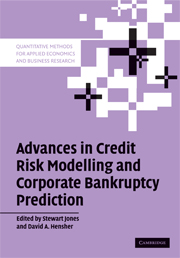Book contents
- Frontmatter
- Contents
- List of figures
- List of tables
- List of contributors
- Introduction
- 1 A statistical model for credit scoring
- 2 Mixed logit and error component models of corporate insolvency and bankruptcy risk
- 3 An evaluation of open- and closed-form distress prediction models: The nested logit and latent class models
- 4 Survival analysis and omitted dividends
- 5 Non-parametric methods for credit risk analysis: Neural networks and recursive partitioning techniques
- 6 Bankruptcy prediction and structural credit risk models
- 7 Default recovery rates and LGD in credit risk modelling and practice: An updated review of the literature and empirical evidence
- 8 Credit derivatives: Current practices and controversies
- 9 Local government distress in Australia: A latent class regression analysis
- 10 A belief-function perspective to credit risk assessments
- Index
- References
1 - A statistical model for credit scoring
Published online by Cambridge University Press: 11 June 2010
- Frontmatter
- Contents
- List of figures
- List of tables
- List of contributors
- Introduction
- 1 A statistical model for credit scoring
- 2 Mixed logit and error component models of corporate insolvency and bankruptcy risk
- 3 An evaluation of open- and closed-form distress prediction models: The nested logit and latent class models
- 4 Survival analysis and omitted dividends
- 5 Non-parametric methods for credit risk analysis: Neural networks and recursive partitioning techniques
- 6 Bankruptcy prediction and structural credit risk models
- 7 Default recovery rates and LGD in credit risk modelling and practice: An updated review of the literature and empirical evidence
- 8 Credit derivatives: Current practices and controversies
- 9 Local government distress in Australia: A latent class regression analysis
- 10 A belief-function perspective to credit risk assessments
- Index
- References
Summary
Acknowledgements: I am grateful to Terry Seaks for valuable comments on an earlier draft of this paper and to Jingbin Cao for his able research assistance. The provider of the data and support for this project has requested anonymity, so I must thank them as such. Their help and support are gratefully acknowledged. Participants in the applied econometrics workshop at New York University also provided useful commentary. This chapter is based on the author's working paper ‘A Statistical Model for Credit Scoring’, Stern School of Business, Department of Economics, Working Paper 92–29, 1992.
Introduction
Prediction of loan default has an obvious practical utility. Indeed, the identification of default risk appears to be of paramount interest to issuers of credit cards. In this study, we will argue that default risk is overemphasized in the assessment of credit card applications. In an empirical application, we find that a model which incorporates the expected profit from issuance of a credit card in the approval decision leads to a substantially higher acceptance rate than is present in the observed data and, by implication, acceptance of a greater average level of default risk.
A major credit card vendor must evaluate tens or even hundreds of thousands of credit card applications every year. These obviously cannot be subjected to the scrutiny of a loan committee in the way that, say, a real estate loan might. Thus, statistical methods and automated procedures are essential. Banks and credit card issuers typically use ‘credit scoring models’.
- Type
- Chapter
- Information
- Publisher: Cambridge University PressPrint publication year: 2008
References
- 10
- Cited by



